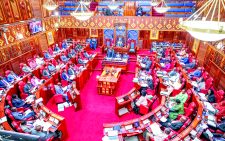Nigeria floods tragedy calls for strong climate adaptation plans

Nigeria’s government is scrambling to provide emergency relief aid after raging floods 10 days ago left more than 200 people dead, 121 injured and more than 1,000 missing in the country’s north-central state of Niger.
Vice-President Kashim Settima, representing President Bola Tinubu, last Wednesday visited the disaster-stricken area and announced emergency relief, including essential goods, 20 trucks of grains, pulses and a reconstruction aid package worth Ksh155.16 million.
The government also established temporary shelters for the affected residents after the flooding destroyed 2,000 homes.
Aid from the federal government was by last Friday, yet to reach many of those affected in Mokwa, the worst-hit area.
The floods said to be the worst in the area for 60 years, swept through the towns of Tiffin Maza and Anguwan Hausawa after torrential rain.
Flooding submerged the market town of Mokwa, causing severe damage.
National Emergency Management Agency described it as one of the worst natural disasters in recent years in Niger State. Settima promised the affected residents sustainable disaster management policies nationwide.
Despite the assurance, the deadly floods show that Nigeria, and indeed others in Africa vulnerable to periodic flooding, and urgently need strong national adaptation plans.
Disaster risk management and adaptation to floods involve a proactive approach to minimising the impact of floods by reducing risk and enhancing resilience.
This includes measures such as identifying flood-prone areas, assessing vulnerabilities, implementing mitigation and preparedness strategies, and devolving recovery programmes.
Effective measures
Key elements of flood disaster risk management include risk assessment by identifying and analysing flood hazards, vulnerability and potential hazards.
It also involves mitigation – implementing structural and non-structural measures to reduce flood risk, such as building levees, floodwalls or zoning restrictions.
Disaster risk management and adaptation to flooding also require developing and implementing disaster preparedness plans, including early warning systems, evacuation procedures, and community education programmes.
It means ensuring effective emergency response during a flood event, including effective emergency response involving search and rescue, shelter, and basic needs provision, as well as developing and implementing plans for post-flood rehabilitation and recovery, including rebuilding infrastructure, restoring livelihoods, and supporting affected communities.
Settima said what happened in Mokwa, an agricultural hub and a cultural stronghold that connects the country’s North and the South, and a vital crossroad in Nigeria’s geography, was “a shared tragedy, a sorrow that touched every stretch of the nation”.
Beyond immediate relief, Shettima outlined the government’s commitment to preventing future disasters, saying the federal government remains committed to addressing ecological challenges that have contributed to the crisis.
The affected residents of Mokwa watched in horror as neighbours were washed away by the ravaging floods.
Usman Ndagi told UK-based Climate Home News digital publication’s reporter Vivian Chime how he woke up to screams as his neighbours were swept away by floodwaters.
“They were calling for help but we couldn’t help them because it was risky,” he said in Mokwa town that smelled of dead bodies. Three of his relatives who had returned home to celebrate Eid, were among more than 200 people killed. “It’s unimaginable,” he said.
Rescue efforts ceased because authorities no longer believed anyone could still be found alive.
To prevent disease in the area, the authorities started to dig out corpses buried underground, Mokwa’s district head, Muhammadu Aliyu said.
One man, Adamu Yusuf, lost his wife and newborn baby.
“I watched helplessly as water washed away my family. I survived because I could swim,” he told the BBC.
Some local residents have said the flooding was so devastating because a nearby dam had burst, however, the authorities have not confirmed this.
Residents said the pressure of the floodwater was so intense that bodies had been washed up in the town of Rabba, at least an hour’s drive from Mokwa. Some bodies were unrecoverable because they had gone “through the River Niger”.
Roads and bridges were also affected by the flood, which had a knock-on effect on the local economy and traffic. The Nigerian Red Cross said the floods had caused “significant loss of life and widespread distress”.
Mitigatable misfortune
Floods are not uncommon during the Nigerian rainy season, which lasts from April until October.
In 2024, Nigeria experienced flooding from heavy rain, which caused deaths and drove people from their homes.
There was also severe flooding in 2022 when more than 600 people died and 1.3 million people were displaced.
Tragically, writes Climate Home’s Chime, the authorities were aware of Mokwa’s vulnerability to this kind of flooding.
Last year, the state government received a Ksh1.29 billion loan from the World Bank to build stormwater drainage structures in the town. But it was too late. The work has yet to begin.
The deadly floods show that Nigeria urgently needs a national adaptation plan. Unregulated homes were built in a usually dry river, contributing to the death toll when the flash flood filled it with water.
It also shows the urgency for rich countries to meet the 2025 target to provide Ksh5.17 trillion of adaptation finance a year – and of the Global Goal on Adaptation talks coming up this week in Bonn and the United Nations climate summit (COP30) in Belém, Brazil, says Climate Home news editor Joe Lo.
While the role of climate change in Nigeria’s latest floods has yet to be established, scientists have found that previous floods in the West African region were worsened by climate change, driven primarily by burning fossil fuels.
“Yet, while adaptation struggles for money, until recently, investment funds in the EU – the biggest market for funds advertised as green – could call themselves ‘sustainable’ or ‘green’ while investing as much as they wanted in fossil fuels,” Lo explained.
The EU’s financial regulator has now called time on that.
It has told fund managers they can’t use sustainability or environment-related terms in their fund names unless they sell off their shares in certain fossil fuel companies.
Faced with a choice between keeping their planet-heating investments or their green-signalling fund names, asset managers like BlackRock chose a bit of both.
After talking to investors, they sold fossil fuel shares in some funds and renamed others.
Many replaced terms like “sustainable” with words like “screened”, “selection”, “transition” or even “net zero” – all terms that allow them to invest as much as they like in fossil fuels under the new European Union (EU) rules. So, it might be time to check which funds your pension is invested in, Lo advised.
Nigeria’s deadly floods show that adaptation finance plays a crucial role in addressing the growing threat of floods and other climate-related disasters.
It involves investing in projects and initiatives that enhance resilience to climate change impacts, including flood prevention and mitigation measures.
The key is to bridge the gap between the funding needed for these adaptation efforts and the resources currently available, particularly on low-income countries.















